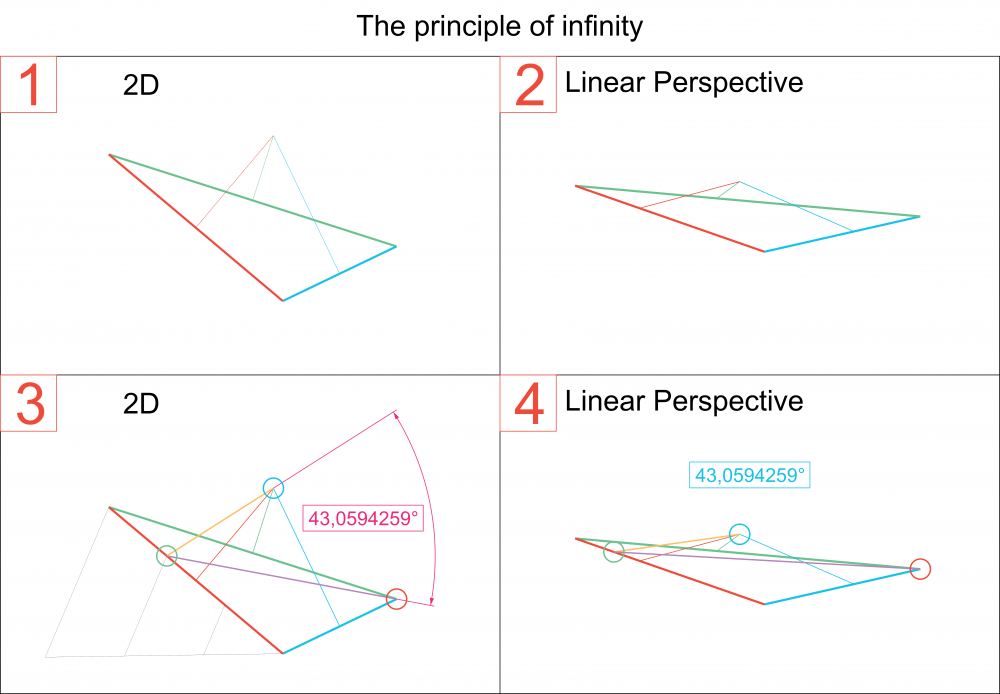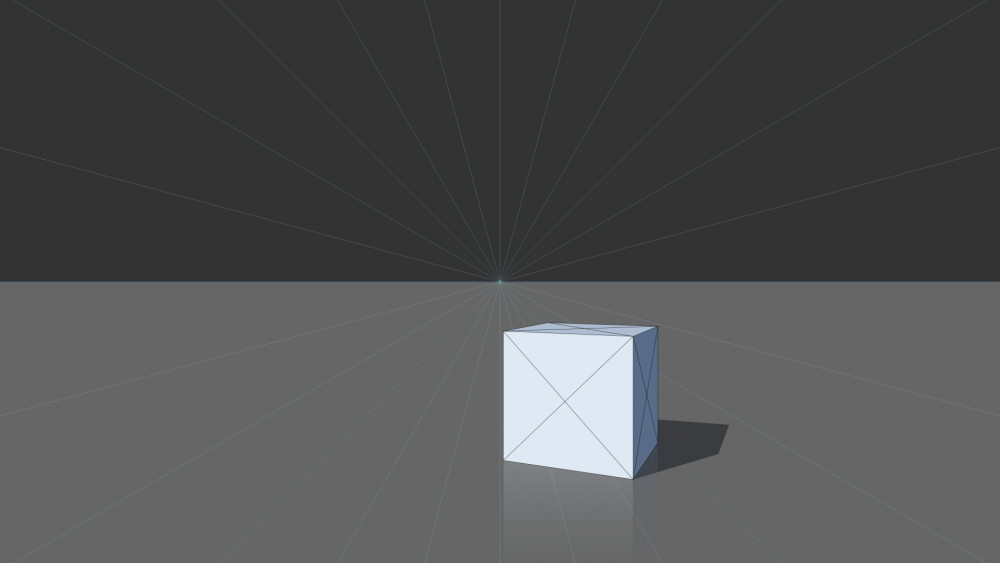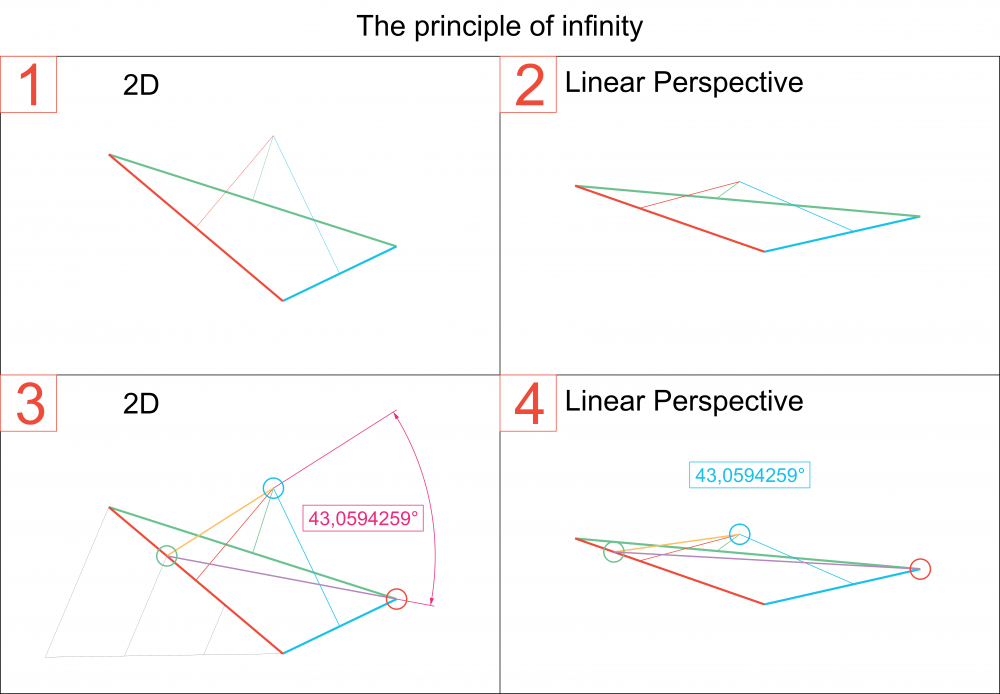

IridiumBoy
Members-
Posts
6 -
Joined
-
Last visited
Content Type
Profiles
Forums
Events
Everything posted by IridiumBoy
-
The pleasure is mine, mate It seems that photogrammetry is something quite complex. Precisely what calls the attention of what I have done is that it is very simple in its behavior. And at the same time, very accurate. Look at this example, I was able to convert with my method a random scalene triangle and all its perpendicular bisectors from 2D to linear perspective, establish a pattern using Thales's first theorem also in perspective, measure the same angle and obtain the same value with that precision. And using only lines. Maybe this is useless in 3D software but at least it could be important in perspective drawing. And more interesting than the method itself, could be the concepts that I used to make it work. For example, what I have done has a lot to do with infinity, and it is the visual equivalent to 1/0=undefined Which does not make much sense with numbers, but it is easier to appreciate with lines. Thank you for your time!
-
Well I tried to explain this at the end of 2021 with an image and some words and there was no way. That is why this time I have decided to share it in a video. If you think you should delete the video, go ahead, I didn't mean to offend. Those who want to search for the video on their own, just write these words on Youtube, the video thumbnail is colored yellow: How reality works visually | The Principle of Infinity Thank you Believe me, I thought I had corrected all the possible misspellings. I checked the video numerous times but it's obvious that I made one. In any case, if the rest of the video is perfectly written in English, I'm satisfied. I can't delete it and upload it again due to a minor mistake, but I thank you anyway. Until I shared it, it was impossible for me to know if this had potential or not. On the other hand, for me the concepts that make this work are more important than the method itself. Maybe they are correct or maybe not, but if they are they could be very interesting. I'm just a designer, your knowledge in these areas is of course greater than mine. That's why I had to share it with all of you. Thanks for your time mate.
-
As Salvador Dali once said: "whoever wants to engage people’s interest must provoke them." So the title of this forum thread was just to get your attention, now that I already have it, let me introduce what I've done. In 2020 during quarantine I discovered a method that successfully connects the different dimensions at a visual level. That way it is possible to convert 2D into 3D and vice versa. This method not only completes to perfection linear perspective, but it could also lead to an endless number of different applications. In addition, it could be useful in different sciences. Recently, I uploaded a video to Youtube showing how it works: This is the cube that I created in the video, it looks like a render made with a 3D design program but it's just a drawing. I'm not sure what I found, but I tried to explain it the best I could. And this video is not a tutorial, that's why I don't explain what I'm really doing. But if there is enough interest, I can do tutorials. From now on, we can discover together the potential of all of this. We only need the right person to see it, that's why the best way to contribute to this discovery is by sharing the video. Thank you very much for your time! and feel free to let me know your opinion.
-
OK I left a link there but they deleted it. Just write IRIDYSCENZIA Deviantart on Google to find my profile in Deviantart to see more examples. I didn't cheat with the results, so if I am right any architect in the world would want to use this method to draw in linear perspective to perfection, not only 'by eye'. Besides, it could even improve the perspective in any 3D software. Thank you four your time mate, really appreciated.
-
I have been reading today about those concepts and no, this is something different. No maths, nor coordinates nor algorithms are needed to make this work. Only a pencil, a piece of paper and some drawing skills, given it only uses lines. And even then, it is 100% accurate. Why? it would be interesting to know. Here you can find more examples of this method mate. Thank you for your comment!
-
During quarantine, one of my purposes was to improve my knowledge about perpective. While I was working on it, I found something, a method that is able to convert information in 2D to linear perspective to perfection, but the most important, to viceversa too. I think that it's like if I had found how both languages are connected between them, the key to translate from one to another. And I am not sure why it works or what it represents, I just know it works. I called this method The Principle of Infinity. What I am going to expose next is the proof that it works, not how it does. You will have to wait for that for now. Let's get started: In the step number 1 we draw a random scalene triangle and the mediatrixes of the three edges that conform the triangle. In the step number 2, using my method, we draw exactly the same triangle and the mediatrixes in linear perspective. But, how can we know now if the triangles in both steps are the same at 100% and not only similar? To know the answer we continue in the step number 3. Using Thales's theorem we divide the red-coloured edge in 3 parts. Now, from one of those parts, we draw a line until one of the vertex of the triangle, de violet line, the one that unites the green circumference and the red one. Where the 3 mediatrixes cut, we have the blue circumference. From there, we are going to draw a line until the green circumference, the yellow line. And now we are going to measure the angle of the vertex between the yellow and violet line. The number in red is the value obtained. As you can see, we established a simple pattern with the intention to compare both triangles. So in the step number 4, we are going to repeat the same pattern but this time in the triangle in linear perspective. It is possible to use the Thales's theorem in perspective, and the rest of the lines are easy to draw. As I said, if It is possible to convert 2D into linear pespective using my method, it is possible to convert linear perspective into 2D too. To finish the step number 4, we convert the yellow and violet lines into 2D using the method, moment when we can measure the angle between them without any kind of distortion. The value in blue is the answer the method gives. The red value and the blue one are completely equals with such accuracy that I cannot think it is only a coincidence, it must mean that the two triangles are exactly the same with no margin of error. Summarizing, what I am really interest to know now is if something like this method has been already made or I am the first person who discovers it. I tried but I found nothing even similar to this, what makes me think. This method is so easy to use that learning perspective in school should be like, first lesson, learn about the horizon line, second lesson, learn what vanishing points are, third lesson, my method, and you are done, you mastered linear perspective. But If I never heard nor read about this It could mean, just maybe, that this has not been already discovered before. And the most important part of this method is not about geometry if not how much of the concepts behind it can be extrapolated to other sciences, specially physics. Because if you can say the universe is made of numbers then you can also say the universe is made of lines, given that geometry is nothing but visual mathematics. This method works as a charm, every time I used it the accuracy was absolute, I never got even the minor error. Perfect. Always. Like a law of physics. To begin with, let's find out if something similar to this has been already discovered. Ask your teachers, mates, anyone interested in geometry, technical drawing, maths, physics, etc. Download the image and share it, share this deviation wherever you want too, share if you think this could be something big and you want to be part of it. Big things have small beginnings too. An then we will see. I don't expect much in the short term, but who knows in the long one. For now, what I have found out thanks to all of this is that universe is nothing but a singularity, and that it is not infinite. Universe is the infinite itself.



